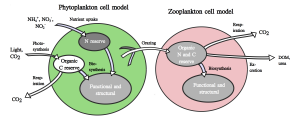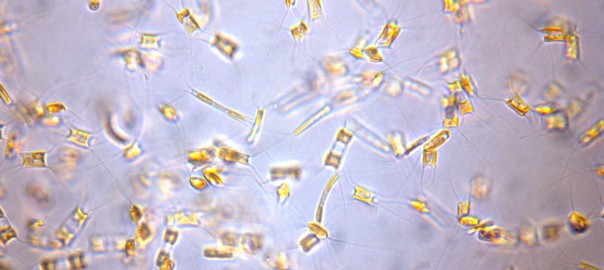The elemental composition of organic matter is remarkably constant throughout the world’s oceans, but phytoplankton are known to take up nutrients and carbon in quite variable ratios depending on light and nutrient conditions.
In a paper published online in the journal Global Biogeochemical Cycles last month, Darwin Project researchers David Talmy (MIT), Christopher Hill (MIT), Anna Hickman (Univ. of Southampton, England), and Mick Follows (MIT), in a collaboration with Adam Martiny (Univ. of California, Irvine), report on their work seeking to understand what ecosystem factors could cause the elemental composition of organic matter to remain stable and relatively constant (homeostatic), even when the phytoplankton can have quite variable composition.
Using a combination of laboratory experiments looking at variable carbon to nitrogen ratios for different plants and animals, along with numerical models and field observations, they find that interactions between primary and secondary producers are likely to be the key to maintaining homeostasis: Even when phytoplankton have carbon content that is extremely elevated, the microzooplankton that consume them may respire excess carbon, and release it back into the water as CO2.

Schematic representation of a phytoplankton cell model and a zooplankton model -
Image courtesy: D. Talmy
This result is likely to be important for climate. The elemental composition of particulate matter in the surface ocean has significant implications for the role of the ocean in mediating atmospheric CO2. The productivity of the ocean is typically regulated by the availability of macro- and micro-nutrients and not inorganic carbon. Thus, the ratio in which carbon is associated with N, P, Fe (and other potentially limiting elemental resources) in sinking organic particles or subducted dissolved organic matter critically controls the efficiency with which carbon is transported to the deep ocean.
The team’s results show that by comparison to microzooplankton, phytoplankton may have systematically different ratios of carbon to nitrogen. Therefore, our understanding of the ocean carbon cycle is likely to depend on our understanding of the relative contributions of these different groups to sinking organic matter.
Publication
D. Talmy, A.C. Martiny, C. Hill, A.E. Hickman, M.J. Follows (2016), Microzooplankton regulation of surface ocean POC:PON ratios, accepted in Global Biogeochemical Cycles, doi: 10.1002/2015GB005273
Story image credit: Richard A. Ingebrigtsen, Department of Arctic and Marine Biology, University of Tromsø
